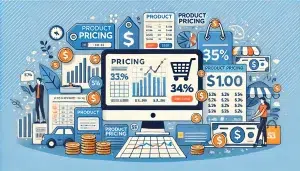Let’s discuss predator pricing, a tactic that has sparked debates, drawn regulatory scrutiny, and created both heroes and villains in the marketplace.
In the world of business, pricing strategies can make or break a company. Among these strategies, predatory pricing stands out as one of the most aggressive and controversial. While predatory pricing may seem like a strategic move to achieve market dominance, it has its own set of pros and cons that have significant impacts on businesses, consumers, and the overall market dynamics.
What is Predator Pricing?
Predator Pricing involves deliberately setting prices below the cost of production or below the prices of competitors with the ultimate goal of driving competitors out of the market or deterring potential new entrants.
Once the competition has been eliminated or significantly weakened, the company then raises prices to recoup losses and maximize profits. This approach can lead to a monopolistic or dominant position in the market, allowing the predator company to control prices and increase market share.
The Mechanics of Predator Pricing
Imagine you’re running a small bakery in a quaint neighborhood. Business is good until a large bakery chain opens a store nearby. The chain starts selling its bread and pastries at prices so low that you can’t compete without incurring losses. Eventually, you might be forced to close your bakery. With less competition, the large chain then hikes its prices, gaining more profit and customers.
This scenario captures the essence of predatory pricing. It’s about leveraging financial strength to undercut competitors, endure short-term losses, and reap long-term gains through reduced competition and higher prices.
The Pros of Predator Pricing
While predatory pricing is often seen in a negative light, it does have its advantages—particularly from the perspective of the company employing the strategy.
1. Increased Market Share
One of the most significant benefits of predatory pricing is the potential to increase market share. By setting prices low enough to attract a large number of customers, a company can quickly expand its customer base. When used as a short-term strategy, this can increase your customer database and increase sales.
2. Elimination of Competition
By driving competitors out of the market, even in the short-term, a company reduces the number of rivals in the market. This reduction in competition can lead to increased pricing power, allowing the company to set higher prices without fear of being undercut by competitors. In the long run, this can lead to higher profits and a more stable market position.
3. Economies of Scale
Larger companies often have the advantage of economies of scale, meaning they can produce goods at a lower cost per unit than smaller competitors. By leveraging this advantage through predatory pricing, large companies can further reduce their costs and improve their profit margins once the competition has been eliminated.
4. Short-Term Customer Benefits
In the short term, customers benefit from predatory pricing as they enjoy lower prices on goods and services. This can lead to increased customer loyalty and higher sales volumes during the period of low prices, which can be beneficial for both consumers and the company offering the discounts.
The Cons of Predator Pricing
Despite potential advantages, predatory pricing is fraught with risks and downsides, both for the companies that employ it and for the market as a whole.
1. Legal and Regulatory Risks
Predatory pricing is illegal in many jurisdictions because it is considered an anti-competitive practice. Companies found guilty of predatory pricing can face hefty fines, legal penalties, and damage to their reputation. Regulatory authorities like the Federal Trade Commission (FTC) in the United States closely monitor and investigate such practices to protect market competition.
2. Unsustainable Financial Losses
Setting prices below cost can lead to significant financial losses, especially if the period of low pricing extends longer than anticipated. Companies engaging in predatory pricing need substantial financial reserves to withstand these losses, and there is no guarantee that the strategy will ultimately succeed in eliminating competitors.
3. Potential for Market Monopoly
If predatory pricing successfully drives out competition, it can lead to a monopoly or near-monopoly situation. While this may initially seem beneficial for the dominant company, it often results in higher prices, reduced innovation, and poorer service for consumers in the long run. Market monopolies are also subject to intense regulatory scrutiny and potential backlash from both consumers and regulators.
4. Damage to Brand Reputation
Engaging in predatory pricing can harm a company’s reputation. Consumers and competitors may view the strategy as unfair or unethical, leading to negative publicity and potential boycotts. A damaged reputation can be difficult to repair and may have long-term consequences for the company’s brand image and customer loyalty.
5. Retaliation From Competitors
Competitors targeted by predatory pricing may not go down without a fight. They might employ their own aggressive pricing strategies, seek legal remedies, or find innovative ways to reduce costs and stay competitive. This retaliation can lead to prolonged price wars, further eroding profit margins for all parties involved.
Should You Implement Predator Pricing?
While predatory pricing is often viewed negatively due to its potential to harm competition and consumer welfare, businesses might choose to use it for short-term boosts, when they are initially entering the market, or gaining customer acquisition.
It can be a highly useful tool, but you need to be careful considering its potential drawbacks and long-term consequences.
Ethically implementing predatory pricing is a complex challenge, but there are a few considerations that businesses can take into account to minimize negative long-term effects on competitors. Here are some ethical strategies to consider:
1. Temporary Promotions
Instead of sustained predatory pricing, businesses can offer temporary promotional pricing to attract customers. This approach can help boost short-term sales without causing lasting harm to competitors.
2. Transparency
Communicating the temporary nature of the pricing strategy to consumers and competitors can help mitigate concerns about unfair competition. Being transparent about the intention behind the pricing can demonstrate ethical behavior.
3. Avoid Monopolistic Intent
Businesses should ensure that their pricing strategy is not aimed at creating a monopoly or eliminating competition. The focus should be on short-term sales stimulation rather than long-term market dominance.
4. Legal Compliance
Always ensure that the pricing strategy complies with antitrust and competition laws to avoid legal repercussions. This can involve consulting legal experts to ensure ethical and legal conduct.
5. Consumer Benefit
The pricing strategy should aim to benefit consumers without causing irreparable harm to competitors. Prioritizing consumer welfare while maintaining a level playing field for competitors is crucial.
6. Sustainable Practices
Consider the long-term sustainability of the pricing strategy for both the business and the industry. Ethical predatory pricing should not jeopardize the overall health of the market.
Ultimately, it’s about utilizing sustainable and ethical business practices which are essential for long-term success and maintaining a positive brand image in the eyes of consumers and regulatory authorities.
Global Perspectives on Predatory Pricing
Predatory pricing has varying perspectives globally. Let’s discuss a few of them:
United States
In the United States it is viewed through the lens of antitrust laws, which aim to promote fair competition. The legal framework focuses on protecting consumers from monopolistic behavior and fostering a competitive marketplace. Companies engaging in predatory pricing can face legal challenges under antitrust laws.
Europe
In the European Union, predatory pricing is also scrutinized under competition laws. The European Commission aims to prevent abuse of dominant market positions and safeguard fair competition. Companies found guilty of predatory pricing can face hefty fines and other penalties.
India
Countries like India have stringent competition laws to prevent predatory pricing and abuse of dominance by market players. The Competition Commission of India (CCI) oversees and regulates such practices.
Latin America
Latin American countries have also been active in enforcing competition laws to curb predatory pricing. For instance, the Brazilian Administrative Council for Economic Defense (CADE) is responsible for enforcing competition regulations in Brazil.
Developing Countries and Emerging Markets
While some developing countries argue that predator pricing can lead to improved consumer welfare through lower prices, others caution against the potential long-term harm to smaller, local businesses and the overall market structure.
Where regulatory frameworks may be less robust, predatory pricing can pose significant challenges. It can hinder the growth of domestic businesses and create barriers to entry for new players, impacting the overall economic development.
Overall, global perspectives on predator pricing vary, reflecting different regulatory approaches, economic philosophies, and concerns about fair competition and consumer welfare. It’s a complex issue that requires a delicate balance between promoting healthy competition and preventing monopolistic practices.
Real-World Examples of Predator Pricing
1. Amazon’s Book Pricing Strategies
Amazon sold printed books and eBooks at prices significantly lower than those offered by competitors, such as traditional brick-and-mortar bookstores. It obtained those books through wholesale purchases at highly discounted rates. By selling books at prices equivalent to the wholesale price available to offline stores, Amazon aimed to eliminate or weaken its competitors.
2. Darling Bus War U.K.
After deregulation of the British bus transport market in 1986, Busways offered free rides to undermine its main competitor, DTC, with the intention of pushing them out of the market. DTC eventually exited the market, and a regulatory commission labeled Busways’ actions as predatory and harmful to public welfare.
3. Walmart / Target Drug War
Walmart and Target engaged in a prescription drug price war, with Walmart offering certain drugs well below the price floor, prompting Target to match these price cuts. Minnesota state law prohibiting the sale of drugs below their stated cost and limited the discount, thus ending the price war.
4. Air Canada
In 2001, Air Canada faced allegations of predatory pricing against two smaller competitors (WestJet and CanJet) by Canada’s Commissioner of Competition. Air Canada introduced special fares to match competitor’s prices, facing complaints regarding anti-competitive behavior.
5. Fresh Foods Ltd Vs. International Grocery Store
An internationally renowned grocery store company located in the same community as Fresh Foods began lowering prices, pressuring Fresh Foods to match its competitor’s prices. After months of pricing pressure, the local mom-and-pop grocery store decided to close up, and the now monopoly grocery store company raised its prices significantly, impacting consumers negatively.
Summary
Understanding the impact of predatory pricing on market dynamics, consumer welfare, and competition is essential for businesses, policymakers, and consumers. Balancing the benefits and drawbacks of predatory pricing is crucial for maintaining a fair and competitive marketplace that ultimately serves the best interests of consumers and businesses alike.
For businesses, the key lies in finding a balance. Competitive pricing is essential, but it must be sustainable and fair. Exploring alternative strategies such as differentiation, cost leadership, and market segmentation can provide competitive advantages without the pitfalls of predatory pricing. Ultimately, a fair and competitive market benefits everyone—businesses, consumers, and the economy as a whole.
Here some links you could find interesting about Predator Pricing topic:




